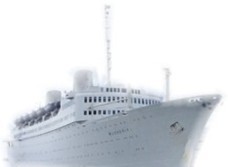 | 
|
| 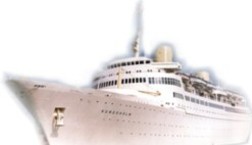 | |||||
A Tribute to the Swedish American Line | ||||||||
| . | ||||||||
| . | ||||||||
| . | ||||||||
 | 
|
|  | |||||
A Tribute to the Swedish American Line | ||||||||
| . | ||||||||
| . | ||||||||
| . | ||||||||
About Us
The Hemingstam Family
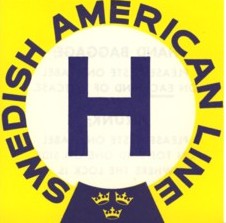
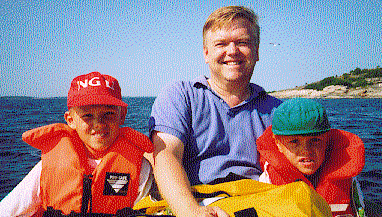
Johan, Lars, and Anders Hemingstam, mid 1990's.
| These 250 pages, in tribute of the Swedish American Line, have since 1998 been created and maintained by me, Lars Hemingstam, and my sons, those uncouth seamen Johan (now 33), and Anders (31). The maintenance is hopefully secured for the next 70 years or so.
Please help us make this site better by mailing us exterior and interior photos of the ships of the SAL fleet, photos and lists of passengers and crew, objects, menues, folders, and so on. Our goal is to have a photo from every Atlantic crossing and every cruise. You can easily figure out that this may take 70 years to accomplish. And please, sign our guestbook and tell us what you think of the site. There are quite a few connections between our family and the Swedish American Line. Several of my mother's relatives from Söderhamn, Sweden, emigrated to the USA in the early 1900's, some of them before 1915, when the Swedish American Line was founded. Later, in the 1920's, three of my grandmother's cousins followed their relatives, sailing to New York on SAL's SS Stockholm and the SS Kungsholm, settling in Chicago, IL, and Barron, WI.
My father, the Rev. Tage Hemingstam, was a member of a Swedish male choir, which, under the name
The Singing Ministers, made a tour of the U.S. in 1954.
He made the westbound Atlantic crossing on the Gripsholm (#1), at that time recently sold to the German shipping company Norddeutscher Lloyd, and made the eastbound crossing on the Kungsholm of 1953.
|
||||
|
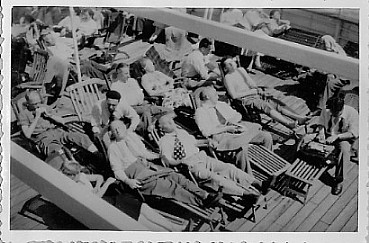 |
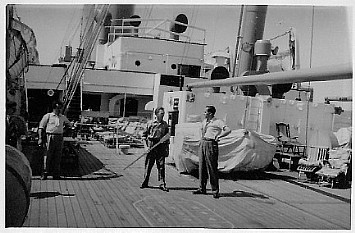 |
|||
Sun-basking on the Atlantic |
Shuffleboard anyone? |
|||
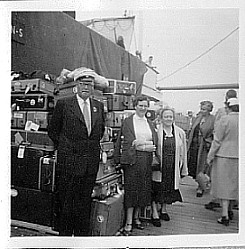 |
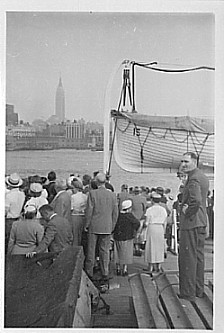 |
|||
A long wait to go ashore | For many, a life-changing voyage. | |||
Photos by Tage Hemingstam
| ||||
In 1957 Tage Hemingstam, his wife Ruth, and their children Gun, Runa, and Lars, applied for immigrant visas, and traveled to the USA to work and study for three years. Tage Hemingstam left Gothenburg on the Gripsholm's maiden voyage, and held the first Sunday Worship Service on board. Tage was born and raised in Jonsered, a suburb of Gothenburg, and like most inhabitants of Gothenburg he knew people who had served on board the SAL ships, and felt proud of the company and its new flagship, the Gripsholm. Read his letter from the maiden voyage here.
The rest of the family followed on the Gripsholm's departure from Gothenburg on July 31, 1957, arriving in New York as bona fide immigrants.
| ||||
A letter from Ruth Hemingstam, published in | ||||
The departure ceremony at Betongskjulet in Gothenburg is overwhelming and exciting. The moorings are hauled on board, a giant crane removes the gangway, thousands of paper serpentines in the air. The ship's orchestra starts to play the Swedish national anthem. Our relatives on the quay are waving and cheering. The Gripsholm slowly glides out. We have soon passed all the small islands and can see the Vinga lighthouse disappear from sight. About 800 passengers walk around and are trying to acquaint themselves with the ship. A couple of hours later we are assigned our table in the beautiful dining room. It's a fiest for a housewife to sit down in the dining room and be served by a pleasant waiter! We get to know the passengers around us. The sheep farmer from Illinois at the table next to ours, left Sweden when he was 19 and had returned to visit his elderly mother, 33 years later. "I cried like a child when I came home!" He didn't have to say more. We all knew how he had felt.
We are taking in the sunshine in the deck chairs, the children play ping-pong on Verandah Deck or go for a swim in the pool, filled with water from the Atlantic. Now and then we stand in line to the ironing room. Everyone wants to be well-pressed for dinner. Twice daily movies are shown in Cinemascope in the Auditorium. We listen to music and have coffee in the Main Lounge. That's also where the games and dancing take place. On the Sunday afternoon, the Auditorium is fully seated for the two sermons, one in English and one in Swedish. There is always one or two pastors among the passengers. Outside our cabin porthole there is nothing but the ocean and the sky as far as we can see. The view is the same every day, but the colors are constantly changing. Sometimes we see large fish jumping above the waves, and a whale came up to the surface to remind us of the secrets of the deep sea. MS Gripsholm, August 1957 | ||||
We lived in Collinsville IL, Chicago IL, and Long Beach CA, about one year in each city. In August 1960, Ruth tragically passed away, and we immediately returned to Sweden by air from Los Angeles.
| ||||
In 1968 I was employed on the MS Kungsholm of 1966 for 6 months as a junior purser (in Swedish 3:e kontorist, i.e.3rd clerk), and made four Atlantic crossings, a Cruise Around South America, a Fall Cruise of Europe and the Mediterranean, as well as a Christmas and New Year’s Cruise of Northern Africa, the Canary Islands, and Madeira. Read about my life as a crew member further down on this page. I was born in a small town called Hjo in Sweden in November, 1946, just a few days before a little girl named Ann-Margret Olsson, then 5 years old, danced over the gangway to embark on the MS Gripsholm to go to USA with her mother, most certainly not aware that she would become one of the world’s most famous entertainers. At the time of the collision between the MS Stockholm and the Italian ship Andrea Doria in 1956, the world press was represented by an editor of Hjo Tidning, the local newspaper in Hjo. The editor was a passenger on the Stockholm and made the scoop of a lifetime.
I am a retired IT consultant, previously dividing my time between Internet projects, writing, and acting. I was married to Kathryn, and we had homes in Sweden and New Hampshire, USA, when she sadly passed away in March of 2015. |
|||||||||||
|
Life as a Crew Member On board the Kungsholm, Autumn of '68
|
|||||||||||
The MS Kungsholm sailed from Göteborg, Sweden, bound for New York on Friday, August 30, 1968, on the same day that The Beatles' single Hey Jude was released. I was newly employed as a junior purser (in Swedish 3:e kontorist, i.e. 3rd clerk), and it was with mixed feelings of anticipation and concern that I left Sweden. The Soviet Union had invaded Czechoslovakia just ten days earlier, and no one could know for sure what was going to happen next in Europe. I remember staring a long time at the lighthouse on the island of Vinga, an image I had grown up with at home, as my mother had made an oil painting of the island thirty years earlier. I had sent a letter to SAL with a job application and was offered a career as a dish washer. At that time I was a technology student in Stockholm (KTH) and Captain Torkel Tistrand at the SAL personnel office assured me that I would be in good company as there were several civil engineers and Ph.D.'s working in the galley. I declined the offer. Then Captain Tistrand called back a few days later and asked if I could type. I sadly replied noooo, and he said I had a week to learn. They needed a clerk on the Kungsholm that was to sail for New York about ten days later. I stayed on the Kungsholm for six months, and made four Atlantic crossings, a Cruise Around South America, a Fall Cruise of Europe and the Mediterranean, as well as a Christmas and New Year’s Cruise of Northern Africa, the Canary Islands, and Madeira. My place of work was the purser’s office, midship on Upper Deck. We were four young men, all under 30, working in the office; in order of rank: the Cashier, the Information Officer, a 2nd clerk and myself, the 3rd clerk. We worked next door to the Chief Purser’s reception room. We had different tasks, but a common concern for the office staff was to prepare the passenger manifests for the ports of call. Every port had its own form for the manifests, demanding information of every passenger’s full name, passport number, date of issue, occupation, home address and in some instances, mother’s maiden name. There were about 450 passengers and we used electric typewriters. The forms were supplied in advance by the SAL local agents in the ports. If there were any mistakes in the passenger lists, there would be trouble with customs and immigration authorities, and the passengers could be delayed going ashore. This had to be avoided, as the passengers had a tight schedule with shore excursions and were eager to leave the ship as soon as the gangway was secured. On one Atlantic crossing we had to retype the passenger manifest 3 times, as we discovered that we had got the alphabetical order mixed up. My salary was SEK 1,400 (Swedish crowns) per month, with a uniform supplement of SEK 4,20 per day. This pay was very low, even for 1968, but as the crew worked every day of the week (Sundays and holidays included), a substantial amount of compensation (vederlag) accumulated during the time at sea. This compensation could be obtained in cash or used as shore leave when the ship returned to Sweden, making it possible for the crew to take long periods of leave and spend months with their families at home. Highest in rank on the ship were the ship's officers on the bridge and the other merchant marine officers who had a formal education giving them authority to run a passenger ship on ocean trade; the Commander, the Chief Officer, the Chief Engineer, the First Radio Operator, and so on. The Chief Purser, the Ship’s Doctor and the Ship’s Chaplain also belonged to this category, giving them the right to dine and mingle with the cruise passengers and the first class passengers on the Atlantic crossings. They dined in the passengers’ dining room. Of course the most prominent passengers were seated at the Captain’s table. Seating the passengers correctly in the dining room was a tricky business, entrusted only to the most experienced head steward and the SAL cruise management staff from the New York office. The category second in rank were the Deck officers, also with formal navy education, who had their meals in the officers’ mess. Invitation to officers' party, 1968 In the next category, to which I belonged, were what we could call the "hotel management staff", such as the head stewards, the staff of the purser’s office, the nurses, the hair dressers, the gift shop's attendants, the ship’s photographers, the musicians, having our meals in our own mess (intendenturmässen). Then we have the rest of the crew, the hard working professional seamen, the engineers, the cabin stewards and stewardesses, the dining room stewards and the deck stewards, and the galley crew, the carpenter, the tailor, the laundry workers, who all had their meals in the crew’s mess. There was very little fraternizing between the different categories on board. This was not questioned in public, it was the way that such things always had been at sea. The members of the staff of the Purser’s Office lived in outward single cabins on B-deck, separated from the passenger area, only accessible via a "crew only" stairway from A-deck. Our cabins were equipped with a berth, a sofa with a table and a writing desk with a chair, a small wash basin and a wardrobe. Showers and toilets were at the end of the corridor. The Deck officers and the staff of the purser’s office had the right to socialize with the tourist class passengers on the Atlantic crossings, and we had our meals in the tourist class dining room. We were not allowed to be in the passenger area on the cruises, nor the first class area during the crossings. However we had the privilege to join the passengers’ shore excursions when the ship was in a port, if there were empty seats on the buses. This way I went on excursions in Lima, Buenos Aires, Rio de Janeiro, Bridgetown, Casablanca, Nice, Monte Carlo and the island of Capri. We had a lot of time off in all the ports, as the purser’s office was closed until about an hour before the ship’s departure. When at sea, we worked every day, Christmas and New Year included.
Another memorable event occurred in the South Atlantic when the fire alarm went off, fortunately being a false alarm. While the elderly passengers were gathering anxiously at their life boat stations, convinced that the ship was about to sink, the ship’s photographer ran from one passenger to the next, begging them to settle their accounts with him. At sea, I had only a fragmentary insight into the daily lives of the cruise passengers, the bridge games in the card room, the lectures, the cha-cha lessons, and - the cocktail parties being arranged with the assistance of the cruise staff - to which the passengers invited each other and sent invitations in return in an intricate social web. The cruise around South America offered 44 days of life in luxury, and the cruise to Europe and the Mediterranean was for 40 days. The average age of the passengers was about 65. I remember one first class passenger saying on an Atlantic crossing, that the best way to travel was to have a first class stateroom, and go to the tourist class lounge in the evenings to have fun. On the cruises, the majority of the passengers were very well to do, and there were "repeaters" treated like royalty, but some were very ordinary senior citizens who had saved money for many years to spend the vacation of their lives on the Kungsholm, "the happy ship with a happy crew".
|
|||||||||||
|
More than 250 web pages developed and maintained by Lars Hemingstam ©1998-2023
Hasse Gustafsson and Tommy Stark have interviewed crew members and contributed many of the stories.
Email us
This site does not use cookies, nor do we save visitors' IP-addresses. We do not send information to any third party. If you find information or a photo about yourself, or a relative, and want do delete it, please email salship@yahoo.com, and the information or photo will be removed. (The General Data Protection Regulation (GDPR) does not apply to deceased persons.) Denna webbsajt andvänder inte cookies, vi sparar inte heller besökarnas IP-adresser. Vi skickar ingen information till tredje part. Om du finner information eller ett foto om dig, eller en släkting, och vill ta bort det, skriv till salship@yahoo.com så tar vi bort informationen eller fotografiet. (EU-regeln GDPR omfattar inte avlidna personer.) |
The New SAL Guestbook
|